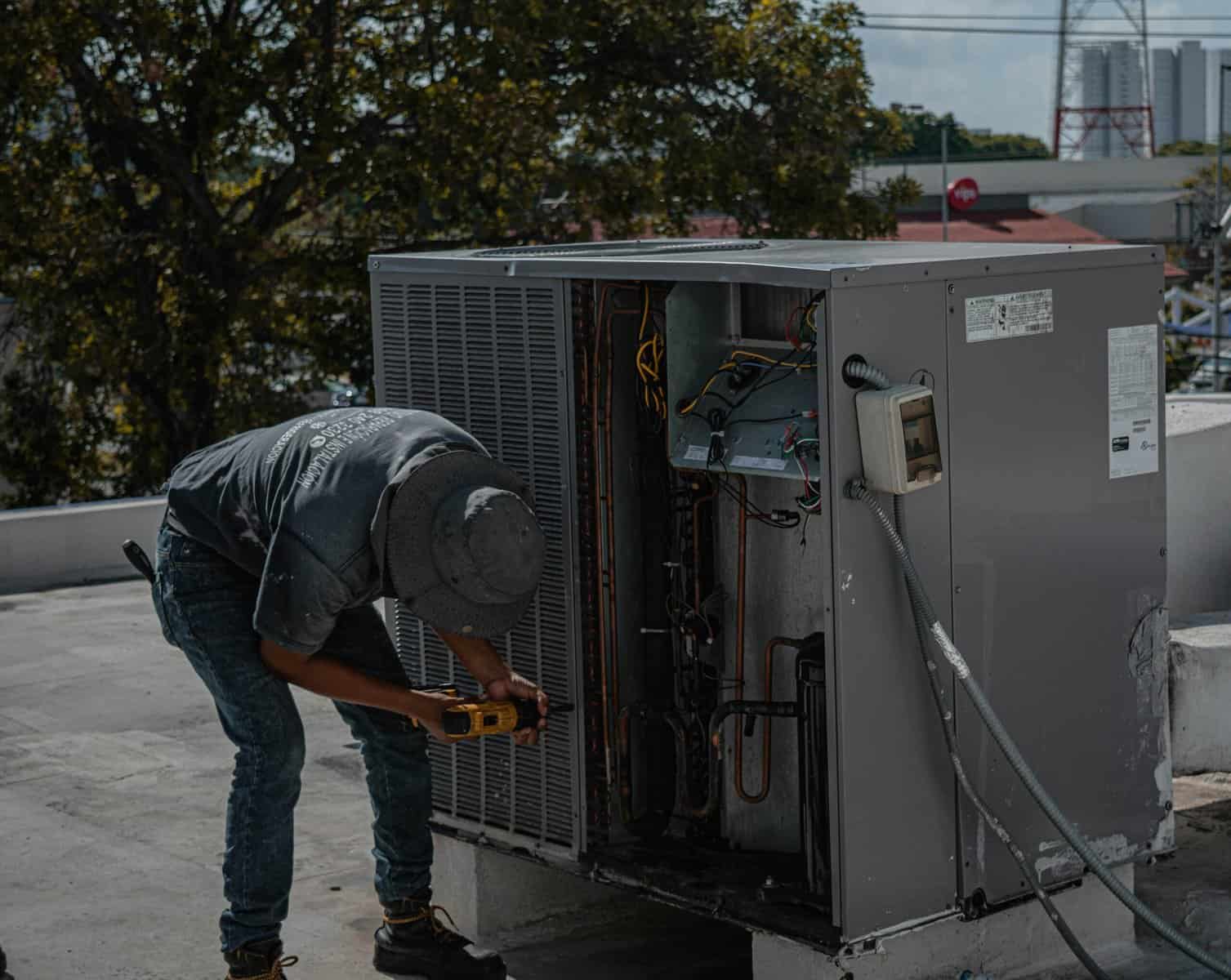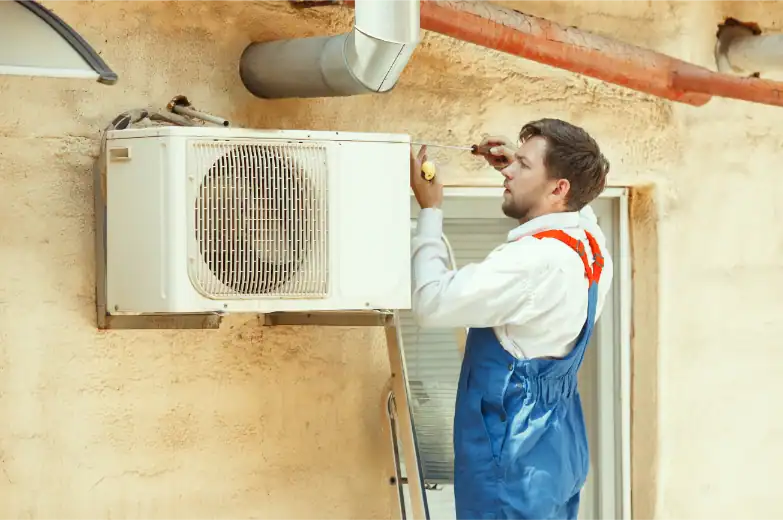Is Mold in Your HVAC Ducts Making You Sick?
Did you know indoor air pollutants from mold in HVAC ducts can be 2 to 5 times higher than outdoor levels? This silent threat grows in your home’s air ducts and seriously affects your health while staying completely hidden from view.
Mold-related health problems in air ducts are systemic and serious. Your HVAC system continuously circulates mold spores throughout your home that trigger symptoms like sneezing, coughing, skin irritation, and fatigue. Black mold in HVAC ducts becomes especially dangerous if you have asthma or a weakened immune system. Long-term exposure can lead to severe conditions like hypersensitivity pneumonitis and cause permanent lung damage if left untreated.
Those unexplained allergies or breathing problems might connect to what lurks in your ductwork. Regular inspection and professional cleaning help prevent these health risks. Affordable Air & Heat provides same-day HVAC services throughout Florida to keep your air clean and your family healthy.
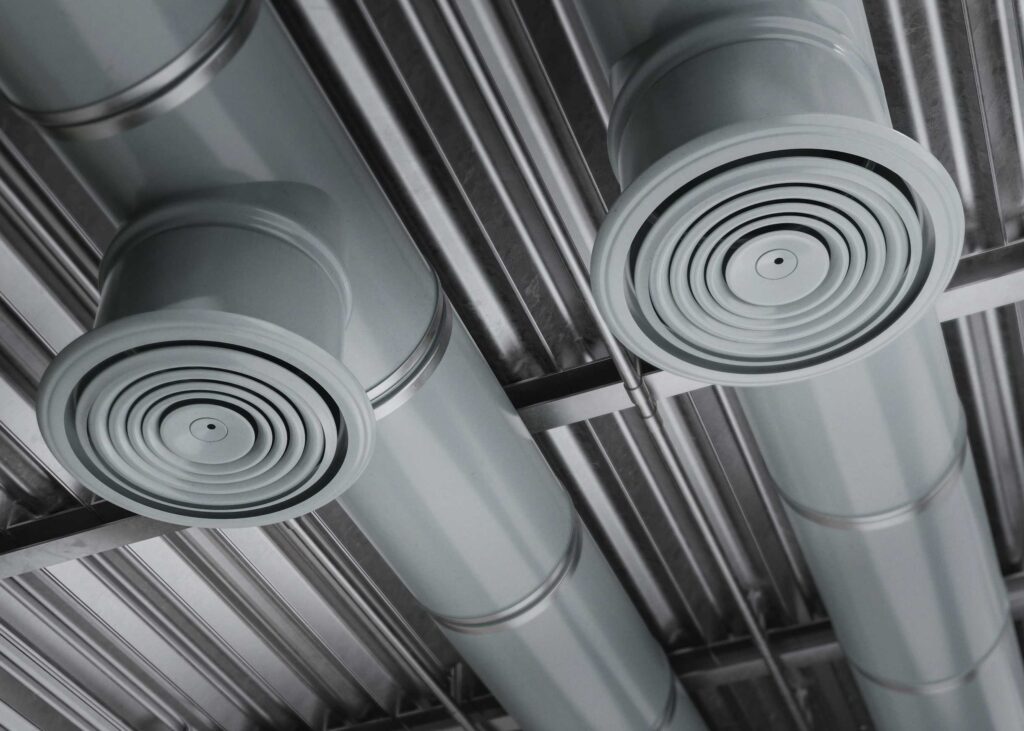
How Mold in Ductwork Affects Your Health
Your HVAC system spreads mold spores through your home every time it runs. These tiny particles can harm your health – from mild irritation to severe breathing problems.
Symptoms of Mold in Air Ducts: Coughing, Sneezing, Fatigue
Your body demonstrates specific physical reactions when mold grows in ductwork. Research shows that mold spores typically cause headaches, sore throats, runny noses, coughing, sneezing, watery eyes, and fatigue. These symptoms often look like a common cold or seasonal allergies, which makes mold exposure hard to spot.
People’s symptoms usually get better when they leave their homes — a clear sign of poor indoor air quality. Mold in your ductwork might be the cause if your family gets sick when the heating or cooling system starts.
Black Mold in HVAC Ducts and Its Toxic Effects
Black mold (Stachybotrys chartarum) raises special concerns because it can produce mycotoxins. Extended exposure to black mold spores leads to severe health issues, including:
- Chronic respiratory issues
- Persistent headaches and dizziness
- Nausea and digestive problems
- Neurological symptoms like “brain fog”
Black mold exposure over time can trigger asthma-like symptoms that cause chest tightness, breathing difficulty, and wheezing. People with weak immune systems might develop serious infections.
Mold Exposure and Worsening of Asthma or Allergies
Mold exposure creates major risks for 26 million Americans with asthma. Research proves that breathing mold spores triggers asthma attacks and makes existing breathing problems worse. Mold reduces lung function and increases hospital visits in people with allergic asthma.
The largest longitudinal study shows that damp or moldy indoor spaces lead to more asthma cases, wheezing, coughing, breathing infections, and allergic rhinitis.
Protect Your Family from Hidden Mold in Air Ducts
Your family’s health deserves protection from contaminated air ducts. Affordable Air & Heat offers
same-day professional air conditioning inspection
and cleaning services across Florida to find and remove mold from your HVAC system.
Call us today to schedule your detailed mold inspection and breathe easier tomorrow.
How Mold Spreads Through Your HVAC System
Your HVAC system can become a pathway for mold to spread throughout your home. The air always contains tiny mold spores. These microscopic spores love dark, damp ductwork and can travel to every room once your system starts running.
Air Circulation and Mold Spore Distribution
Tiny mold spores float invisibly in indoor air. These spores multiply rapidly after finding
moisture in your HVAC system. They form colonies that release millions more spores. Your forced air system then becomes a network that pushes these harmful particles into every corner of your home.
The air flow through contaminated ducts stirs up mold spores whenever your heating or cooling kicks in. Spores can quickly spread from one area to another. Mold growing in your basement’s ductwork can easily reach your bedrooms, kitchen, and living room.
Mold vs Dust in Air Vents: How to Tell the Difference
You can spot clear differences between mold and regular dust buildup:
- Mold clings to surfaces like black soot and forms visible patches or specks
- Dust looks gray and powdery, typically accumulating on the bottom of vents
A musty, earthy smell gets stronger when your HVAC runs – this usually means mold, not dust. Black particles coming from vents during operation point strongly to mold contamination.
Why Mold in Vents Keeps Coming Back
Mold returns until you fix what causes it. Leaky ducts let moisture, dust, and warm air sneak in — creating perfect conditions for mold growth. The mold will come back even after cleaning if these leaks stay unfixed.
Poor duct insulation creates condensation where cool air meets warm air. Moisture builds up and gives mold the perfect place to grow. Dirty filters trap moisture and become breeding grounds for mold that moves through your system.
Detecting and Cleaning Mold in Air Ducts
Mold detection in your HVAC system needs specialized knowledge and equipment. You might notice visible signs of a problem, but the most dangerous infestations hide in your ductwork’s unseen areas.
When to Call a Certified Mold Inspector
Untrained eyes can’t spot all mold issues. You should reach out to a licensed mold inspector if you notice:
- Your HVAC system produces musty, earthy odors when running
- Your respiratory symptoms improve when you’re away from home
- Black spots or discoloration appear around vents or ductwork
- You’ve experienced recent water damage or humidity problems
Licensed inspectors come equipped with proper gear to assess mold problems safely without disturbing spores that could spread through your home. They provide accurate assessments by analyzing air and surface samples in laboratories.
Air Quality Testing and Moisture Checks
Professional mold testing tells you whether you’re dealing with toxic mold or a harmless lookalike. Specialists use different technologies to detect mold and find hidden water sources. A single laboratory sample costs about $50.
Certified inspectors check moisture-prone areas like basements and HVAC systems with specialized tools that measure mold levels. Thermal imaging cameras help spot hidden moisture problems that promote mold growth.
EPA-Approved Mold Removal Techniques
EPA guidelines for indoor air quality warn against running your HVAC system if you suspect mold contamination because it could spread spores throughout your building. Professional remediation has these steps:
- Containment of affected areas to prevent cross-contamination
- HEPA vacuum and air scrubber use to capture microscopic spores
- Application of EPA-approved antifungal treatments
- Removal of severely contaminated porous materials
Why DIY Mold Cleaning Often Fails
DIY mold cleaning attempts usually make things worse. Untrained cleaning disturbs mold and sends spores airborne throughout your home. Regular cleaning methods can’t reach mold growing between walls or deep in ductwork.
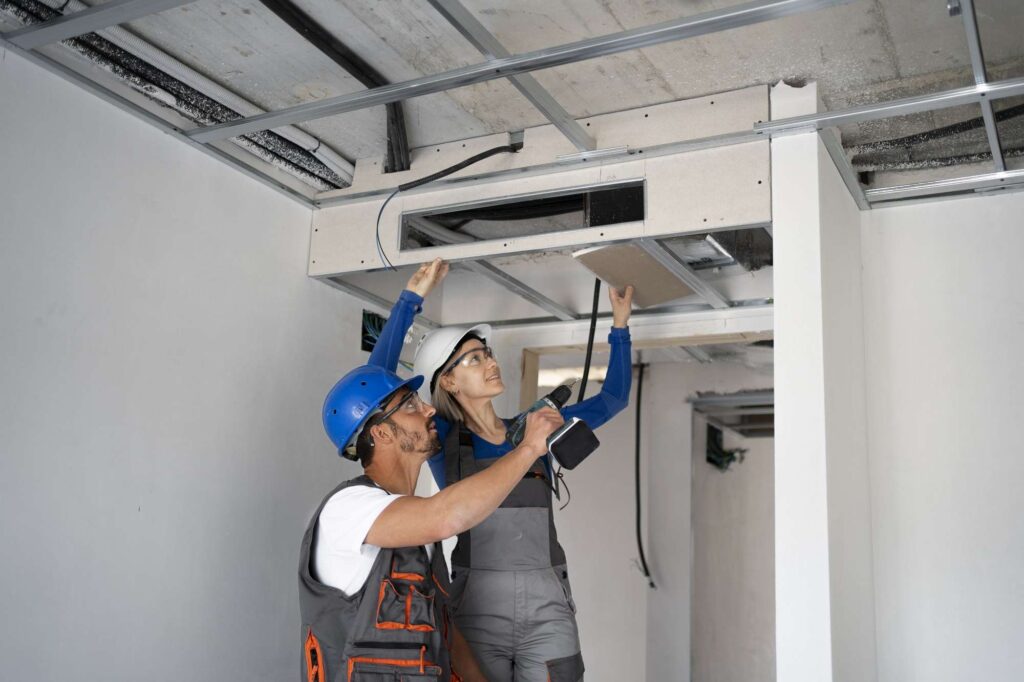
Preventing Mold Growth in HVAC Ducts
You can prevent mold growth in your HVAC system through proactive maintenance and smart upgrades. These preventative measures help you avoid getting pricey remediation bills and protect your family’s health.
Choosing the Right Air Filters for Mold Prevention
Your first defense against mold in HVAC ducts begins with proper filtration. Minimum Efficiency Reporting Values, or MERVs, report a filter’s ability to capture larger particles between 0.3 and 10 microns (µm). This value is helpful in comparing the performance of different filters.
Filters rated MERV 8–13 catch mold spores as small as 3 microns. Standard filters need replacement every 30–90 days based on their quality and your home’s conditions. Homes with allergies or pets need high-efficiency filters that trap mold spores for better protection.
HEPA filters catch 99.97% of particles down to 0.3 microns, which makes them ideal for stopping mold.
Sealing Leaky Ducts to Prevent Moisture Intrusion
Leaky ducts create the perfect environment where mold thrives. These gaps let moisture seep into the system and create breeding grounds for mold. A professional duct sealing job streamlines processes and saves energy.
Your HVAC technician uses remote cameras during airflow tests to spot trouble areas. Sealed connections and joints stop warm and cold air mixing, which cuts down condensation that feeds mold growth.
Scheduling Regular Duct Cleaning Every 2–3 Years
Professional duct cleaning should happen every 2–3 years. Homes with pets, allergies, or those in humid areas like Florida need yearly maintenance. National Air Duct Cleaners Association (NADCA) certified professionals clean your entire system—from coils and drains to registers and blower assemblies. Yearly checkups catch problems early before they turn serious.
Using UV Lights and Ionizers for Long-Term Protection
UV-C light technology targets mold right at its source by breaking down microorganisms’ DNA. These systems block mold growth on evaporator coils and drain pans where moisture collects naturally.
HVAC systems with UV lights eliminate up to 99% of airborne viruses and bacteria while keeping mold under control. The best protection comes from combining UV technology with top-quality air filters.
Don’t Let Mold Become a Health Hazard
Mold shouldn’t become a health risk in your home. Reach out to Affordable Air & Heat for same-day duct inspection and sealing services anywhere in Florida.
Schedule Your HVAC Mold Inspection Today
Our certified professionals use advanced techniques to detect and address mold in HVAC ductwork. Every inspection includes:
- Visual examination of your ductwork
- Moisture meter readings and thermal imaging scans
- Air and surface sample testing
- Post-remediation clearance testing for peace of mind
The EPA recommends leaving mold remediation in HVAC systems to trained experts. DIY methods often fail to resolve the underlying issue — but we don’t.
Call now to schedule your professional mold inspection with Affordable Air & Heat. We offer fast, reliable service across Florida — including same-day appointments.
Q1. Can mold in HVAC ducts affect my health?
Yes, mold in air ducts can significantly impact your health. When your HVAC system runs, it can circulate mold spores throughout your home, potentially causing symptoms like coughing, sneezing, skin irritation, and fatigue. Long-term exposure may lead to more severe respiratory conditions, especially for those with asthma or weakened immune systems.
Q2. How can I tell if there's mold in my air ducts?
Signs of mold in air ducts include a musty odor when your HVAC system is running, visible black spots or discoloration around vents, and unexplained respiratory symptoms that improve when you’re away from home. If you suspect mold, it’s best to call a certified mold inspector for a professional assessment.
Q3. How often should I have my air ducts cleaned to prevent mold?
Experts typically recommend professional duct cleaning every 2–3 years. However, homes in humid climates or those with pets or allergy sufferers may benefit from annual maintenance. Regular cleaning helps prevent mold growth and maintains good indoor air quality.
Q4. Can I clean mold from my air ducts myself?
DIY mold cleaning of air ducts is not recommended. Untrained cleaning can disturb mold, causing spores to become airborne and spread throughout your home. Professional remediation is necessary to safely and effectively remove mold, identify the source of moisture, and prevent future growth.
Q5. What steps can I take to prevent mold growth in my HVAC system?
To prevent mold growth, use high-quality air filters (MERV 8–13) and replace them regularly. Minimum Efficiency Reporting Values, or MERVs, report a filter’s ability to capture larger particles between 0.3 and 10 microns (µm). This value is helpful in comparing the performance of different filters. Seal any leaky ducts to prevent moisture intrusion. Consider installing UV lights in your HVAC system to inhibit mold growth. Maintain proper humidity levels in your home and schedule regular professional inspections and cleanings of your HVAC system.
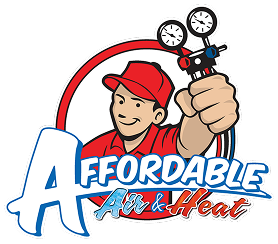
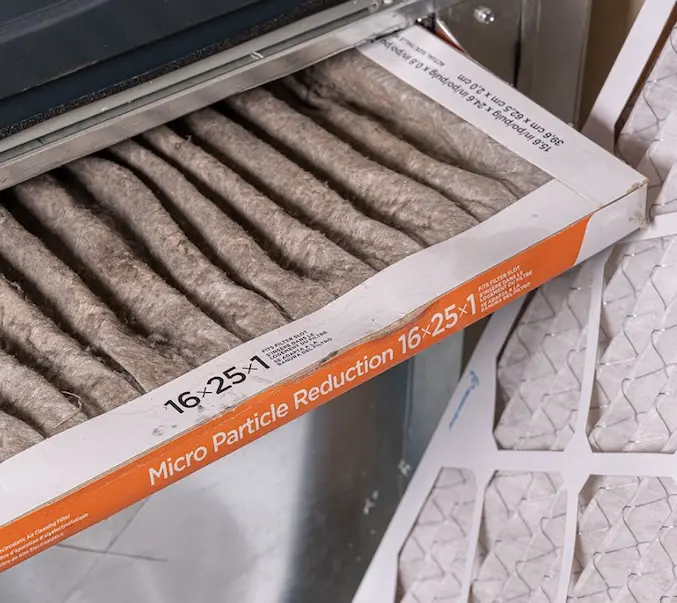
![Mini Splits vs Central Air: Which Saves More in Florida? [2025]](https://affordableair.com/wp-content/uploads/2025/09/mini-air-vs-central-air.png)

